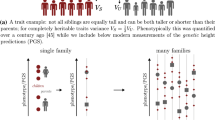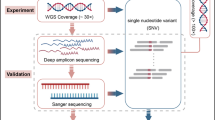Abstract
Zygosity diagnosis has been performed in 79 pairs of twins using three methods. Simple sequence repeat length polymorphism (SSLP) analysis allows an efficient classification (MZ or DZ) with only a few markers following a simplified technique of extraction and amplification. A method based on a full questionnaire completed by parents about twin similarity correctly classifies 97.46% of the pairs; 92.41% are correctly classified using only four questions as suggested by logistic regression analysis. The third method, using dermatoglyphic analyses, correctly classifies 86.76% of pairs. To lower the cost of DNA diagnosis we stress the possibility of limiting its use to pairs with scores in the overlap area between MZ and DZ twins with a validated questionnaire.
Similar content being viewed by others
References
Armour, J. A. L., and Jeffreys, A. J. (1992). Biology and applications of human minisatellite loci.Curr. Opin. Genet. Dev. 2:850–856.
Akane, A., Matsubara, K., Shiono, H., Yamada, M., and Nakagome, Y. (1991). Diagnosis of twin zygosity by hypervariable RFLP markers.Am. J. Med. Genet. 41:96–98.
Bennett, P., Henderson, D., Stanier, P., Vaughan, J., and Moore, G. (1992). Determination of twin zygosity by DNA hybridisation to wild type bacteriophage M13.Br. J. Obstet. Gynaecol. 99:858–860.
Bonnelykke, B., Hauge, M., Holm, N., Kristoffersen, K., and Gurtler, H. (1989). Evaluation of zygosity diagnosis in twin pairs below age seven by means of a mailed questionnaire.Acta Genet. Med. Gemellol. 38:305–313.
Cohen, D. J., Dibble, E., Grawe, J. M., and Pollin, W. (1975). Reliably separation identical from fraternal twins.Arch. Gen. Psychiat. 32:1371–1375.
Derom, C., Bakker, E., Vlietinck, R., Derom R., Van den Berghe, H., Thiery, M., and Pearson, P. (1985). Zygosity determination in newborn twins using DNA variants.J. Med. Genet. 22:279–282.
Eufinger, H., Rand, S., Scholz W., and Machtens, E. (1993). Clefts of the lip and palate in twins: Use of DNA fingerprinting for zygosity determination.Cleft Palate-Craniofacial J. 30:564–568.
Goldsmith H. H. (1991). A zygosity questionnaire for young twins: A research note.Behav. Genet. 21:257–269.
Hagelberg, E., Gray, I. C., and Jeffreys, A. J. (1991). Identification of the skeletal remains of a murder victim by DNA analysis.Nature 352:427–429.
Hosmer, D. W. and Lemeshow, S. (1989).Applied Logistic Regression, John Wiley and Sons, New York.
Jeffreys, A. J., Wilson, W., and Thein, S. L. (1985). Individualspecific “fingerprints” of human DNA.Nature 316:76–79.
Lench, N., Stanier, P., and Williamson, R. (1988). Simple noninvasive method to obtain DNA for gene analysis. Lanceti:1356–1358.
Motomura, K., Tateishi, H., Nishisho, I., Okasaki, M., Miki, T., Tonomura, A., Takai, S. I., Mori, T., and Jeffreys, A. J. (1987). The zygosity determination of Japanese twins using a minisatellite core probe.Jpn. J. Hum. Genet. 32:9–14.
Neitzel, H., Digweed, M., Nürnberg, P., Pöpperl, A., Schmidt, C. A., Tinschert, S., and Sperling, K. (1991). Routine applications of DNA fingerprinting with the oligonucleotide probe (CAC)5/(GTG)5.Clin. Genet. 39:97–103.
Polymeropoulos, M. H., Xiao, H., Torrey, E. F., DeLisi, L. E., Crow, T., and Merril, C. R. (1993). Search for a genetic event in monozygotic twins discordant for schizophrenia.Psychiat. Res. 48:27–36.
Porrini S. C., Sciarra, A., Sulli, N., Piane, M., Gualtieri, R., and Del Porto, G. (1990). Variable number of tandem repeats in zygosity diagnosis in twins.Acta Genet. Med. Gemellol. 39:473–477.
Reed, T. (1986). Blind assessment of zygosity using dermatoglyphics from the NHLBI twin study.Am. Dermatoglyph. Assoc. Newlett. 5:6–11.
Reed, T., Norton, J. A., Jr., and Christian, J. C. (1977). Sources of information for discriminating MZ and DZ twins by dermatoglyphic patterns.Acta Genet. Med. (Roma) 26: 83–86.
Reed, T., Uchida, I. A., Norton, J. A., and Christian, J. C. (1978). Comparisons of dermatoglyphic patterns in monochorionic and dichorionic monozygotic twins.Am. J. Hum. Genet. 30:383–391.
Reed, T., Carmelli, D., and Rosenman, R.H. (1991). Effects of placentation on selected Type A behaviors in adult males in the National Heart, Lung, and Blood Institute (NHLBI) twin study.Behav. Genet. 21:9–19.
Routman, E., and Cheverud, J. (1994). A rapid method of scoring simple sequence repeat polymorphisms with agarose gel electrophoresis.Mamm. Genome 5:187–188.
Saiki, R. K., Scharf, S., Faloona, F., Mullis, K. B., Horn, G. T., Erlich, H. A., and Arnheim, N. (1985). Enzymatic amplification of β-globin genomic sequences and restriction site analysis for diagnosis of sickle cell anemia.Science 230:1350–1354.
Smith, S. M., and Penrose, L. S. (1955). Monozygotic and dizygotic twin diagnosis.Ann. Hum. Genet. 19:273–289.
Spitz, E. (1994).Etude d'une des variables de l'environnement maternel prénatal: effets à court et à long termes du type de placenta chez les jumeaux monozygotes, Thèse de l'Université Paris V René Descartes, Paris.
Spitz, E., Carlier, M., Vacher-Lavenu, M. C., Moutier, R., Reed, T., Busnel, M. C., and Roubertoux, P. L. (1994). The effect of MZ chorion type on variation in anthropological measures, intelligence and cognitive processes.Behav. Genet.,24:531 (abstr.).
Sprague, F. R. (1976).Dermatoglyphic Patterns of Fingers, Palms and Soles: Analysis of Genetic Variance in Twins and Use in Zygosity Determination, M. S. thesis, Indiana University, Bloomington.
Taylor, B. A., Navin, A., and Phillips, S. J. (1994). PCR-amplification of simple sequence repeat variants from pooled DNA samples for rapidly mapping new mutations of the mouse.Genomics 21:626–632.
Vlietinck, R., Derom, C., Derom, R., Van den Berghe, H., and Thiery, M. (1988). The validity of Weinberg's rule in the East Flanders Prospective Twin Survey (EFPTS).Acta Genet. Med. Gemellol. 37:137–141.
Vogel, F., and Motulsky, A. G. (1979).Human Genetics Problems and Approaches, Berlin, Springer-Verlag.
Weber, J. L., and May, P. E. (1989). Abundant class of human DNA polymorphism which can be typed using the polymerase chain reaction.Am. J. Hum. Genet. 44:388–396.
Weissenbach, J., Gyapay, G., Dib, C., Vignal, A., Morissette, J., Milasseau, P., Vaysseix, G., and Lathrop, M. (1992). A second-generation linkage map of the human genome.Nature 359:794–801.
Author information
Authors and Affiliations
Rights and permissions
About this article
Cite this article
Spitz, E., Moutier, R., Reed, T. et al. Comparative diagnoses of twin zygosity by SSLP variant analysis, questionnaire, and dermatoglyphic analysis. Behav Genet 26, 55–63 (1996). https://doi.org/10.1007/BF02361159
Received:
Accepted:
Issue Date:
DOI: https://doi.org/10.1007/BF02361159




